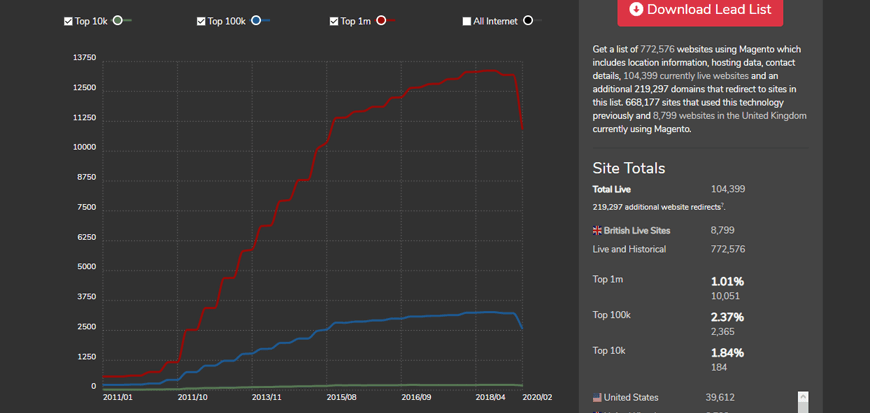
If you still don’t know what the Magento Commerce platform is, in this article, we will clarify the main doubts regarding this which is one of the most advanced systems for creating virtual stores.
When it comes to an eCommerce platform or eCommerce development solutions, it can be said without fear of exaggeration that Magento is one of the most complete solutions on the market at the moment.
Of course, there are other quite sophisticated and complete e-commerce systems on the market, but thinking about setting up e-commerce without knowing the features and functionality of the Magento Commerce platform makes you ignore a very competitive platform option.
In this article we will show you everything important to know about Magento and why the platform is one of the most used in the world for creating more robust online stores.
An ECommerce Platform with Tradition in the Market
The Magento Commerce platform is an old one known to high performance virtual store platform developers.
For its resources and versatility, we can say that when it comes to open source e-commerce platforms, it is among the top of the line in terms of resources and technology.
The Magento project was born at the initiative of Varien in 2007, in the wake of other initiatives to develop e-commerce systems in open-source formats such as the extinct osCommerce and Prestashop, which were pioneers in this model.
In 2008, the company launched the first open version of the system that became known as Magento Community Edition – CE , and gradually conquered a good share of the market.
Since then, the Magento Commerce platform has established itself as an industry standard and due to its technological resources and advanced solutions for e-commerce.
We currently see major brands such as Droga Raia, Pernambucanas, Nestlé, Marabrás, and others working with Magento as the heart for their e-commerce operations.
In 2011, the eBay group acquired part of Magento’s shares and concluded the company’s purchase in June of the same year, becoming the majority shareholder of the company.
Continuing its saga, in May 2018, Adobe bought the platform and continued its updates and improvements, even offering Adobe Cloud as support for its system.
Magento Commerce Platform and its market share in 2020
According to a survey conducted by the cminds website, in 2020, the Magento Commerce platform held 1.4% of the total sites with e-commerce systems, a position that was already higher, but that remains relevant.

The fact is that despite being an open source platform and therefore relatively “cheap”, maintenance is considered very expensive for small companies.
Magento hosting requires high performance servers, which makes it more expensive, and in addition, it is relatively difficult to find professionals for Magento stores who are really capable of working with Magento .
For these reasons, the platform lost some positions in the market, mainly among small and medium-sized companies that started to adopt e-commerce as a sales channel.
Due to the costs involved that I mentioned earlier, small and medium entrepreneurs are giving preference to the use of other open-source e-commerce platforms, such as virtual stores with WooCommerce, or even rented virtual stores.
What is the Magento Platform and what features does it offer?
As previously stated, the Magento Commerce platform is an open-source e-commerce system, developed in PHP, a widely known programming language.
The system is distributed free of charge on the company’s website and also in the developer community that works to improve and add new features to the system.
As it is an open source e-commerce platform, anyone who has solid programming knowledge, since the code is quite sophisticated, can promote changes and develop new functions for the system.
As a characteristic of this type of platform, it is possible to say that there are no limits to the customization of a virtual store created on this platform, which contributed a lot to its acceptance by the market.
Magento Commerce Platform Architecture
Now knowing what the Magento Commerce platform is, let’s take a look at other aspects of this e-commerce system so that you can make the right decision.
An interesting feature of the Magento platform is that it is part of a modular architecture model, where the system actually consists of several independent modules that together make up the virtual store.
This is a very common logic in this type of system, is also adopted in the virtual stores created with WordPress, in partnership with e-commerce plugins for this solution.
Magento Extensions or Plugins
The modules for Magento are known as Magento Extensions, or plugins for Magento and are one of the platform’s strengths.
The purpose of these modules is to be able to add new features to the platform and thereby make it even more interesting for the visitor and also more functional for those who administer it.
Currently, there are free and paid Magento Extensions. In the first case, you’ll find several of them on the Magento Marketplace, the official Magento plugin directory, where there are literally hundreds of options
In the same directory, you can also find paid extensions, developed by companies and independent programmers, that offer some very sophisticated solutions.
Endless layout possibilities for the Magento online store
Another interesting point about the Magento Commerce platform is the design options and layouts you can count on, called templates, that totally modify the look of the store.
There are websites specializing in the sale of Magento templates, such as Theme Forest, where you can find a multitude of templates that can be purchased to give your online store a personalized touch.
In this area, there is even a very interesting book, authored by André Gugliotti, called Temas Em Magento, which can help you a lot in this matter.
Magento Platform Hosting
The special care that you need to take when working with the Magento Commerce platform concerns the hosting of the system, which we see as one of the great challenges to use this e-commerce solution.
As we said earlier, the platform is quite robust, and this inevitably leads to very heavy consumption of the hosting provider’s resources.
Therefore, when choosing a hosting provider for Magento, you need to make a rigorous technical analysis of the services offered by the provider and their actual performance.
Unfortunately, some hosting companies offer this service, without actually having the technical capacity to support a system as demanding as in the case of Magento, which makes numerous requests to the database.
As you can see, the Magento Commerce platform offers a number of advantages for those who want to build robust and versatile e-commerce. It is not for any other reason that in our e-commerce course we pay special attention to this platform, especially for those who want to develop a large virtual store.
Now that you know all the potential of the Magento Commerce platform, its advantages and restrictions, consider the possibility of adopting it in your e-commerce project. Or consider us as your Magento development company, we have years of experience and fully dedicated to delivering ingenious Magento development services and solutions for your business. Our Magento products will uplift your business to the next level.